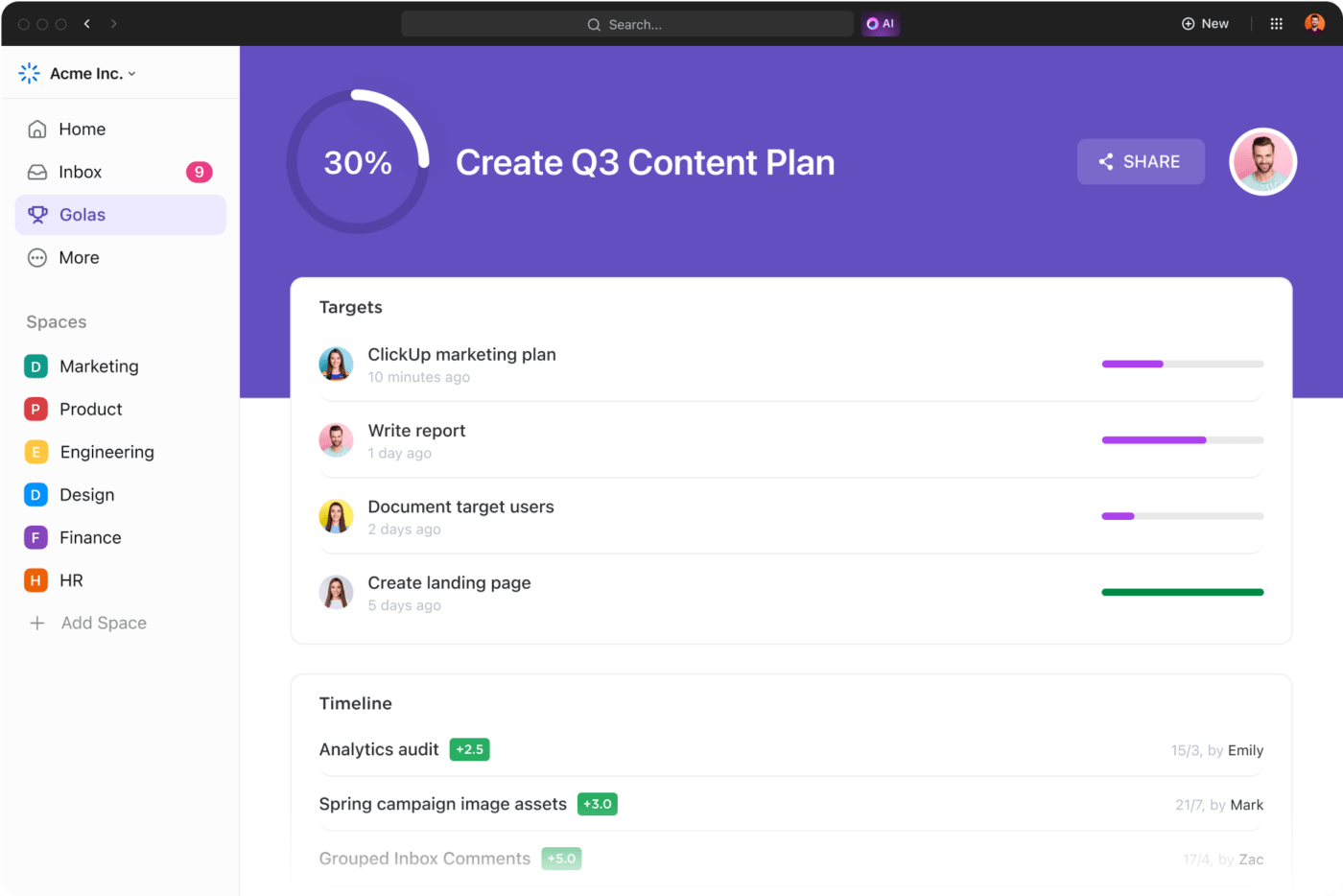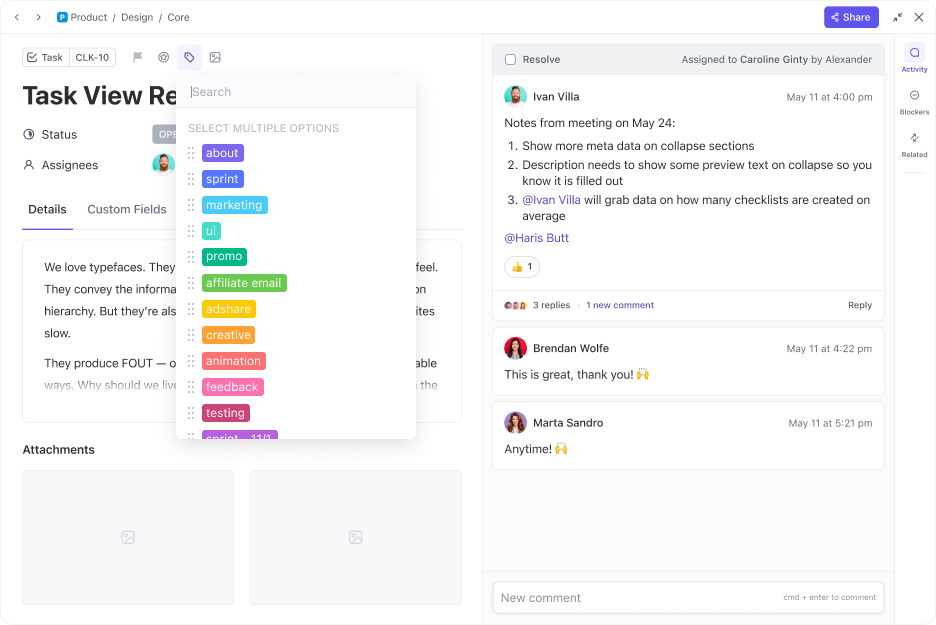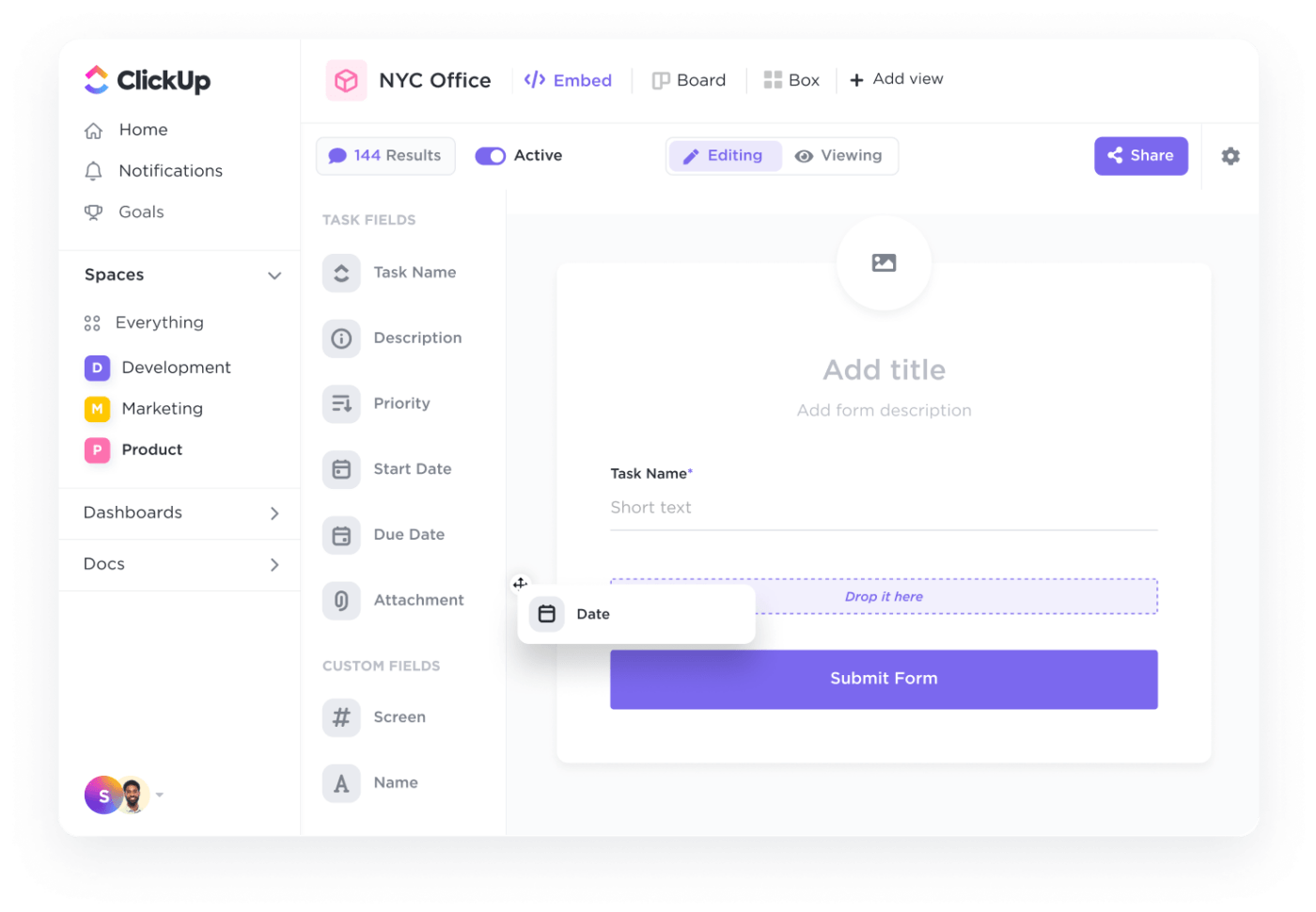سيؤكد أي شخص يعمل في مجال التمويل أن التخطيط لميزانية التسويق هو فن وعلم في آن واحد. إذا أنفقت بسخاء كبير في الأموال، فهناك خطر عرقلة استثمارات النمو الأخرى. ولكن إذا أنفقت أقل مما ينبغي، فسوف ينحرف مسار مبيعاتك بالكامل! 😅
إن معايرة إنفاقك التسويقي هو جزء غير قابل للتفاوض في مواءمة أهداف عملك مع مبادرات التسويق الشاملة. ولكن هناك العديد من العوائق التي تعيقك، مثل عدم وجود تنبؤات موثوقة للسوق أو صوامع العمليات. وفقًا لـ إحصائيات من MDG للإعلانات ، فإن 91% من الشركات تعتقد أن البيانات غير الدقيقة هي السبب الرئيسي وراء سوء الإنفاق في التسويق.
متوسط ميزانية التسويق تشكل ما يقرب من 10% من إجمالي إيرادات الشركة ، ولا يمكن لأي شركة أن تتحمل إهدار هذا النوع من الموارد على ميزانية تنطوي على مخاطر الإنفاق الزائد وضعف العائد على الاستثمار. لحسن الحظ، لدينا مجموعة من النصائح والاستراتيجيات المناسبة لمساعدتك.
سيساعدك دليل ميزانية التسويق الخاص بنا على استكشاف بعض المفاهيم الأساسية لابتكار استثمارات تسويقية جيدة وتجنب المزالق الشائعة.
مكافأة: سنستكشف أيضًا كيفية إتقان تخصيص ميزانية التسويق الفعالة مع انقر فوق وهو حل تسويقي مجاني لإدارة المشاريع والتسويق.
ما هي ميزانية التسويق؟
تهدف أي خطة تسويق إلى تحسين عائد الشركة على الاستثمار (ROI). تحتاج إلى معرفة ما إذا كانت الحملة تُترجم إلى إيرادات كافية لتبرير تكاليف التسويق. ميزانية التسويق هي إطار العمل الخاص بك لتحديد كل مخصصات مالية متعلقة بالتسويق بعناية ضمن معايير محددة مسبقًا، مما يضمن إنفاق الأموال على السبل الثابتة.
إنها تشمل كل جانب من جوانب الإنفاق التسويقي، وتحدد من، وماذا، ولماذا، وكيف لكل نفقة متوقعة، وعادةً ما تمتد على مدار ربع سنة إلى سنة مالية كاملة.
هذه الاستراتيجية تخصيص الموارد يضمن أن استراتيجيات التسويق المواءمة مع أهداف العمل الشاملة - فأنت توجه الأموال إلى الحملات التي من المتوقع أن تحقق أعلى عائد استثماري وتتجنب الاستثمارات التسويقية غير المربحة.
تخضع الميزانية التسويقية المقترحة عمومًا للتدقيق والموافقة والتخصيص، وغالبًا ما يكون ذلك قبل أشهر من الحملة التسويقية المستهدفة. ومع ذلك، فهي وثيقة ديناميكية، ويمكنك دائمًا تغييرها وفقًا لأهداف العمل الحالية, الجمهور المستهدف والمشهد التنافسي واتجاهات السوق ⚡
نصيحة احترافية: يكون إنشاء ميزانية للإنفاق التسويقي أسهل بكثير إذا كان لديك الإطار الصحيح - أي نماذج ميزانية التسويق - لتبدأ بها. لماذا لا تستكشف قالب ميزانية التسويق ClickUp ?

يمكنك زيادة عائد الاستثمار إلى أقصى حد باستخدام قالب ميزانية التسويق ClickUp. تنبأ بالإنفاق التسويقي المستقبلي، وحسِّن التكاليف، وتحكم بشكل كامل في عمليات إعداد ميزانيتك
يساعد في تحويل أكثر مخططات ميزانية التسويق تعقيدًا إلى ميزانيات مرئية سهلة المتابعة. تساعدك النظرة العامة الشاملة للميزانية التسويقية الشاملة المكونة من صفحة واحدة في نموذج ميزانية التسويق على التنبؤ وإجراء التعديلات أثناء التنقل.
لماذا تعتبر ميزانية التسويق مهمة، وهل تستحق وضع ميزانية تسويق؟
قد يجادل العديد من المسوقين بأن إنشاء ميزانية تسويق وتحديثها يستغرق وقتًا طويلاً حيث لا يمكنك أبدًا الحصول على تقديرات دقيقة بنسبة 100%. ومع ذلك، فإن وضع خطة ميزانية تسويقية قوية يوفر العديد من المزايا، مما يتيح لك
- التخطيط المسبق: تخصيص الأموال للمشاريع قبل عدة أشهر، مما يضمن التنفيذ دون عناء
- توسيع الموارد: توظيف موظفين مستقلين وموظفي تسويق متخصصين لتيسير المساحة الإبداعية لديك
- تقييم العائد على الاستثمار: احسب عائد التسويق على الاستثمار (MROI) لاتخاذ قرارات مستنيرة تتماشى معأهداف الشركة
- إظهار القيمة: إظهار قيمة الأنشطة التسويقية وتخصيص الميزانية لجميع المشاريع للمديرين التنفيذيين في الشركة
- قياس التقدم المحرز: مقارنة التقدم المحرز على أساس سنوي,تتبع فعالية كل منهامشروع تسويقي
أين تذهب ميزانية التسويق؟
في الماضي، اعتادت فرق التسويق التقليدية على تفضيل النشرات الإعلانية المادية واللافتات والإعلانات التلفزيونية لنجاح الشركة. لقد انقلب الوضع تمامًا في عصرنا الحالي، وذلك بفضل التركيز الأكبر بشكل ملحوظ على التسويق الرقمي.
وفقًا لـ استطلاع ديلويت 2023 أن الشركات تنفق أكثر من 50% من ميزانيتها التسويقية على التسويق الرقمي، مع تخصيص 19% منها لأنشطة الهاتف المحمول و17% لإعلانات وسائل التواصل الاجتماعي.
استنادًا إلى أحدث الاتجاهات، فيما يلي مراكز تكلفة حملة التسويق القياسية:
- الإعلانات المدفوعة، بما في ذلك إعلانات الدفع لكل نقرة واللافتات والإعلانات التلفزيونية
- المؤتمرات أو المعارض التجارية أو المعارض داخل المتاجر
- الكتيبات والتصميم الجرافيكي وتغليف المنتجات
- تسويق المحتوى (المدونة ومنشورات وسائل التواصل الاجتماعي)
- المستقلون والمؤثرون والوكالات لمهام العلاقات العامة (العلاقات العامة)
- الاستطلاعات ومجموعات التركيز وأنشطة أبحاث السوق
- البرامج وصيانة المواقع الإلكترونية والبنية التحتية الرقمية
- الهدايا والمواد الترويجية
- نفقات تشغيلية متنوعة
ماذا تشتمل الميزانية المكتوبة للحملات التسويقية؟
إذن، لا تقتصر صياغة الميزانية على تضمين المعلومات المالية فقط. يجب عليك إضافة مكونات سياقية إلى توقعاتك حتى يتمكن أي شخص يراجعها من الحصول على صورة كاملة للمبادرة.
تتألف ميزانية التسويق المتكاملة عادةً من
- الأهداف المالية: مخطط واضح للأهداف المالية المرتبطة باستراتيجيات التسويق
- استراتيجية تحديد المواقع : تحدد كيفية وضع العلامة التجارية نفسها في السوق
- استراتيجية العلامة التجارية : الاستراتيجية الشاملة لتعزيز هوية العلامة التجارية
- لمحة عامة عن المنتج أو الخدمة: تفاصيل شاملة عن المنتجات والخدمات ومقترحات القيمة الفريدة
- أهداف محددة للميزانية: أهداف مفصلة لكل منتج أو قناة توزيع أو خدمة عملاء
- خطة المبيعات: الاستراتيجيات الموضوعة لزيادة المبيعات بما يتماشى مع جهود التسويق
- الحملات الرئيسية: تحديد ومخطط الحملات التسويقية المهمة
- تواريخ مراجعة التقدم المحرز: جداول زمنية مجدولة لتقييم حالة الميزانية مقابل المعايير المحددة
كيفية حساب ميزانية تسويقية معقولة: الأساليب الشائعة
الـ إرشادات إدارة الأعمال الصغيرة الأمريكية بتخصيص حوالي 7-8% من إجمالي إيراداتك الإجمالية للتسويق. ومع ذلك، يمكن أن تكون ميزانيات التسويق القائمة على الإيرادات أحادية البعد.
لا يمكن استثمار 8% من إيراداتك للتسويق إلا إذا كانت هوامش ربحك واسعة بشكل معقول. في حين أنه من السهل على الشركات الراسخة، فإن الشركات التي تحقق أرباحًا متساوية، أو الأسوأ من ذلك، التي تعمل بخسارة، لا يمكنها الالتزام بهذه النسبة.
هناك بعض الطرق الأخرى لحساب ميزانيتك التسويقية المستهدفة، مثل:
- الميزانية المطابقة للمنافسة: أنت على استعداد لإنفاق نفس المبلغ الذي ينفقه منافسوك. هذا هو المبدأ المستخدم عادةً لحساب الإنفاق الإعلاني الرقمي
- الميزنة على أساس الصفر: أنت لا تعتمد على السجلات السابقة ولكنك تبدأ الميزانية من الصفر وتبرر كل نفقة للحصول على الموافقة. عليك أن
- تحديد أهدافك التسويقية الحالية
- تحديد أولويات أساليب التسويق التي تحتاج إلى المزيد من الموارد
- مراقبة كل مخصص لتجنب الإفراط في الإنفاق
- الميزنة القائمة على الأهداف: تقوم ببناء ميزانية بناءً على الهدف المستهدف مع وجود قيود قليلة أو معدومة على التكلفة
6 خطوات لإنشاء ميزانيات تسويق ناجحة ## 6 خطوات لإنشاء ميزانيات تسويق ناجحة
ميزانية التسويق هي جهد تعاوني بين المديرين التنفيذيين الماليين وفرق التسويق وقادة البرامج في شركتك. ومع ذلك، فإن إنشاء ميزانية تسويق فعالة هو أكثر من مجرد أشخاص وأرقام، فهو يتعلق بتحديد مسار للنمو والعمل الاستراتيجي.
إليك ملخصًا سريعًا لست خطوات حاسمة لإنشاء ميزانيتك التسويقية. لتبسيط العملية، قمنا بعرض الوظائف مع مجموعة ClickUp للتسويق لتقسيم بعض الخطوات 🌟
الخطوة 1: حدد أسلوبك وأهدافك التسويقية
الخطوة الأولى لإنشاء ميزانية تسويقية هي تحديد الأهداف التي تبرر ذلك. على سبيل المثال، يمكنك التفكير في وضع أهداف تركز على:
- زيادة المبيعات
- تسريع توليد العملاء المحتملين
- زيادة الوعي بالعلامة التجارية
- إعادة تحديد موقع العلامة التجارية
ومع ذلك، فإن الدقة أمر حيوي. الغموض الأهداف الأسبوعية مثل "زيادة المبيعات" تفتقر إلى الوضوح والتوجيه. إليك تمرين يمكنك القيام به:
- دوّن أهداف عملك الشاملة
- حدد الأهداف التسويقية قصيرة الأجل وطويلة الأجل:
- تركز الأهداف قصيرة الأجل على التحسينات الفورية، مثل تقليل معدلات الارتداد عن الموقع الإلكتروني أو دفع الإعلانات عبر الإنترنت
- الأهداف طويلة الأجل تشمل إنجازات أوسع نطاقاً، مثل تحسين محرك البحث أو أتمتة التسويق الفعال
- إنشاءمؤشرات الأداء الرئيسية (مؤشرات الأداء الرئيسية) - ستساعد لاحقًا في تحديد التفاصيل في الميزانية
استخدم أهداف النقر لإعداد أهدافك التسويقية بمؤشرات أداء رئيسية قابلة للقياس. تتبع الأهداف أسبوعيًا وشهريًا وربع سنويًا وسنويًا، واربطها مباشرةً بمهام أو مشاريع محددة، مما يعزز التحسين المستمر في مساعيك التسويقية.

وضع أهداف قابلة للقياس للمهام والمشروعات مع التقدم التلقائي لتحقيق الأهداف بفعالية أكبر مع جداول زمنية محددة وأهداف قابلة للقياس الكمي
نصيحة: إذا كنت تكافح من أجل تحديد أهدافك التسويقية، التزم بـ SMART (محددة، وقابلة للقياس، وقابلة للتحقيق، وذات صلة، ومحددة زمنيًا) معايير لتحديد الأهداف المركزة. يسمح لك هذا الإطار بإبقاء أهدافك واقعية وقابلة للتنفيذ.
الخطوة 2: ابحث عما ينفق عليه منافسيك
بمجرد أن تعرف أهدافك، ابدأ في البحث عن الإنفاق التسويقي لمنافسيك. للبدء، اطرح هذين السؤالين:
- _ من الذي يحقق أداءً جيدًا في المجال؟
- _ما هي استراتيجيات التسويق ومخصصات الميزانية التي يستخدمونها؟
قم بدراسة قنوات مثل التسويق عبر المواقع الإلكترونية ووسائل التواصل الاجتماعي والتسويق عبر الفيديو وإعلانات الدفع بالنقرة. ادرس تكتيكات التسويق لدى المنافسين وتكرار الرسائل ونماذج النجاح. حدّد أوجه التشابه والاختلاف مع أساليبك التسويقية الخاصة بك لصياغة عرض البيع الفريد الخاص بك.
هل تحتاج إلى أداة سريعة للمقارنة؟ استخدم قالب التحليل التنافسي ClickUp لتخطيط حالة جميع رواد الصناعة والمنافسين. يوفر عرضًا تفاعليًا، مما يسمح بتعديل مرن للعلامة التجارية وتحديد موقعها. يمكنك تقييم أداء ميزانيتهم بناءً على مقاييس محددة مسبقًا أو تحديد نقاط القوة والضعف لديهم وصياغة استراتيجيات أكثر ذكاءً.
بمجرد حصولك على الأرقام، يمكنك البدء فورًا في توثيق ميزانيتك باستخدام مستندات ClickUp . أضف صفحات متداخلة، وقم بتخصيص التصميم والجداول والتعديلات في الوقت الفعلي مع زملائك في التسويق لوضع ميزانيتك المقترحة. 🧮

تعاون مع أعضاء الفريق في مستندات ClickUp Docs لتخصيص الخطوط أو إضافة علاقات المهام أو الارتباط بالمهام مباشرة في المستند
إذا كنت لا تريد إضاعة الوقت في كتابة تقارير البحث، استخدم منشئ استبيانات أبحاث السوق بالذكاء الاصطناعي من ClickUp للحصول على مستندات تسويقية منظمة بشكل جيد في غضون ثوانٍ.

تجعل وظائف الذكاء الاصطناعي في ClickUp من السهل على فرق التسويق إنتاج مستندات مهمة بسرعة مثل دراسة الحالة
الخطوة 4: قم بتعيين احتياطي نقدي للتكاليف غير المتوقعة
كن محددًا للغاية عند تخصيص الميزانية - احتفظ بعناصر مثل العوائد المتوقعة وجدول التمويل بشفافية فائقة. ومع ذلك، حتى التخطيط الأكثر تفصيلاً للميزانية لا يمكن أن يضمن دائمًا إنفاقك الفعلي. فماذا لو واجهت نقصًا في الأموال في المستقبل؟
قم بتخصيص جزء من ميزانيتك كصندوق طوارئ لتغطية التكاليف غير المتوقعة مثل إحباط تحركات المنافسين العدوانية أو الاستفادة من الفرص المفاجئة. يجب أن يكون هذا الاحتياطي عادةً بنسبة 10% من إجمالي ميزانيتك. فهو بمثابة شبكة أمان ويضمن المرونة في الاستجابة لـ الأحداث غير المتوقعة .
يمكنك الآن تتبع مخصصات ميزانيتك التسويقية في جداول بيانات متعددة الاستخدامات باستخدام ClickUp Accounting . تساعد مجموعة الميزات هذه على تبسيط المهام المالية وتتبع الإنفاق التسويقي وإنشاء التقارير. يمكنك تصنيف أموالك (مثل الاحتياطي النقدي أو الإنفاق على إعلانات Google) باستخدام الحقول والعلامات المخصصة لتسهيل التتبع.

البحث من خلال الوسوم التي تم إنشاؤها مسبقًا، وإنشاء وسوم جديدة، وإضافة وسوم متعددة مباشرةً داخل المهمة
يمكنك أيضًا إعداد أتمتة ClickUp لمراقبة متى تجاوزت في الإنفاق وتحتاج إلى إجراء تعديلات. عمليات التشغيل التلقائي في ClickUp لا تحتاج إلى تعليمات برمجية وقابلة للتخصيص.
مكافأة: تابع ميزانيتك التسويقية أثناء العمل باستخدام نموذج محاسبة ClickUp والإشراف على الفواتير وحالة الصندوق وسجلات المبيعات والدخل وتوقعات الإيرادات.
الخطوة 5: إرسال الميزانية للموافقة عليها
بعد تحديد التكاليف وإعداد الاحتياطيات النقدية، ضع بعض اللمسات النهائية على ميزانيتك التسويقية وأرسلها للموافقة عليها. تعتمد الجهة التي ترسلها إليها على التسلسل الهرمي لفريقك وشبكة الموافقة.
يحتوي ClickUp على العديد من ميزات الاتصال لمساعدتك على البقاء على اطلاع أو طلب توضيحات أثناء سير عمل الموافقة. المنصة عرض الدردشة أداة قيّمة لتبادل المعلومات الأساسية أثناء الموافقات على الميزانية والتحديثات الخاصة بالمشروع. إذا كنت أنت من يقوم بالموافقة، يمكنك أيضًا استخدام انقر فوق التدقيق لترك تعليقات على أقسام الميزانية.

اجمع اتصالات الفريق معًا في مساحة واحدة مع ClickUp Chat وشارك التحديثات واربط الموارد وتعاون دون عناء
الخطوة 6: تنفيذ الميزانية وجمع الملاحظات بانتظام
لا تكتفي بتنفيذ ميزانيتك وتنسى أمرها. مراجعة خطتك التسويقية وميزانيتك بانتظام أمر ضروري لمواكبة احتياجات العمل المتطورة.
استخدم التحليلات من برنامج التسويق الخاص بك لتقييم العائد على الاستثمار وتكييف ميزانيتك بناءً على تغييرات السوق أو فعالية الحملة. قم بقياس مؤشرات الأداء الرئيسية لكل حملة وقناة لتحسين تخصيص الميزانية.
من الطرق الذكية لمراقبة ميزانيتك التسويقية إعداد المخططات الدائرية والرسوم البيانية المتعلقة بالتمويل في لوحات معلومات ClickUp . من تحديد الأولويات وتحديد الأولويات إلى تتبع التقدم المحرز وتقييم أداء الفريق، إنه المكان المناسب إذا كنت تريد رؤية شاملة لمشاريعك. 📈

استخدم التنقل لأسفل في لوحات معلومات ClickUp Dashboards لتغيير المهام أو تحديثها داخل المخطط لإجراء تعديلات سلسة
التدقيق الشهري أو الفصلي في الإنفاق الفعلي مقابل مقاييس الأداء، وتعديل المخصصات في الوقت الفعلي - تنعكس التغييرات على الفور في مساحة العمل الخاصة بك.
يسهّل ClickUp أيضًا مشاركة استراتيجية عملك المحدّثة وتقويم المبيعات وإصدارات المنتجات ومستندات العملاء المستهدفين مع فريق التسويق لديك. إذا كنت ترغب في ذلك، يمكنك طلب ملاحظاتهم من خلال نماذج ClickUp .

أنشئ النموذج الذي تحلم به وحسِّن عملية الاستقبال الخاصة بك باستخدام ميزة النماذج القابلة للتخصيص في ClickUp
إذا انتهى بك الأمر إلى مهام جديدة لتحسين الميزانية، قم بتنظيمها في عرض التقويم حتى لا تفوتك أي مواعيد نهائية.

تنظيم المشاريع وتخطيط الجداول الزمنية وتصور عمل فريقك على تقويم مرن في ClickUp
إنشاء ميزانية تسويق: الأخطاء الشائعة
ينطوي إعداد ميزانيتك التسويقية على العديد من المكونات المعقدة، مما يترك مجالاً كبيراً للأخطاء. غالبًا ما يعاني أصحاب الأعمال الصغيرة في تخصيص ميزانية التسويق لأنهم لا يستطيعون تحمل تكاليف المهنيين لتوجيههم.
انتبه لهذه الأخطاء الشائعة في تخطيط الميزانية.
الاعتماد على ميزانية التسويق للعام الماضي
يخضع السوق لتحولات مستمرة مع تطور أولويات المستهلكين. ما نجح بشكل فعال في عام ما قد يفقد تأثيره في العام التالي.
قم بإعادة تقييم ميزانيتك التسويقية بدقة لفهم كيف أثرت التطورات التكنولوجية والتحولات السياسية والحركات الاجتماعية الناشئة وعوامل أخرى على سلوك المستهلك. في الوقت المناسب رؤى العملاء ستساعدك على تحديد فرص التسويق أو سحب الاستثمارات السيئة قبل أن تؤدي إلى خسائر فادحة.
ضعف التوازن بين الإعلانات التقليدية والتسويق البديل
يجب أن توازن الشركات بين الاستثمارات بين الاستراتيجيات التي تم اختبارها عبر الزمن والاستراتيجيات الناشئة لتظل مرنة.
غالبًا ما ينطوي العثور على استراتيجية التسويق المثالية على التجربة والخطأ. من النادر العثور على نهج مثالي من المحاولة الأولى. ومع ذلك، لا تبالغ في التجريب. بدلاً من اعتماد أساليب عشوائية غير مركزة وعشوائية، اتجه إلى بعض المبادرات التسويقية التي أثبتت نجاحها بشكل موثوق.
_هل ما زلت مترددًا في تخصيص ميزانيتك التسويقية المثالية؟ قد تساعدك قاعدة 70-20-10 على تحقيق إطار عمل متوازن. إليك كيفية عملها:
- 70% من ميزانيتك تذهب إلى الاستراتيجيات التي أثبتت نجاحها
- 20% لاستكشاف استراتيجيات جديدة
- تُترك نسبة ال 10% المتبقية للمقاربات التجريبية، مما يتيح مجالاً للابتكار والمخاطرة
الإفراط في إعطاء الأولوية لاكتساب عملاء جدد
في حين أنه غالبًا ما يكون هناك تركيز كبير على اكتساب عملاء جدد يدفعون في التسويق، إلا أن هناك قيمة كبيرة في رعاية العملاء الحاليين.
تشير الأبحاث إلى أن اكتساب عميل جديد يمكن أن يكلف حوالي خمسة أضعاف تكلفة الاحتفاظ بالعميل الحالي. بالإضافة إلى ذلك, دراسة أعدها فريدريك رايشيلد من شركة بين آند كومباني أن زيادة 5% فقط في الاحتفاظ بالعملاء يمكن أن تزيد معدلات الاحتفاظ بالعملاء بشكل كبير من الأرباح بنسبة تصل إلى 95%.
إن بناء الولاء بين قاعدة عملائك الحاليين ليس فقط فعالاً من حيث التكلفة، بل يعزز أيضاً علاقة أقوى وأكثر ديمومة مع العملاء، مما يساهم بشكل كبير في تحقيق النجاح على المدى الطويل.
الاعتماد على بيانات غير دقيقة
تسهّل البيانات التحليلية الحصول على بيانات مستنيرة صنع القرار مما يتيح لك اتخاذ مخاطر محسوبة، والاعتماد في بعض الأحيان على الغرائز أو الحدس. يمكن أن يؤثر استخدام بيانات غير دقيقة أو غير موثوقة بشكل كبير على عملية تخطيط ميزانيتك.
ومع ذلك، فإن وجود كميات وفيرة من البيانات لا يضمن جودتها تلقائيًا. من الضروري استخدام استراتيجيات قوية لتنقية البيانات للتخلص من التكرارات وعدم الدقة والأشكال الأخرى من البياناتالسيئة_.
استمتع باتصالات تسويقية وميزانية سلسة مع ClickUp
هل سئمت من ميزانيات التسويق التي تتلاشى بدلاً من أن تزدهر؟ قد تبدو صياغة ميزانية تسويقية شاملة مثل التلاعب بجداول البيانات في خيمة سيرك. 🤹
ولكن مع وجود حل شامل مثل ClickUp، يصبح العصف الذهني والتخطيط والتنفيذ سهلاً للغاية. بالإضافة إلى ذلك، فإن مساعد الذكاء الاصطناعي يمكن أن يساعد فريقك على أن يكون أكثر كفاءة بمرور الوقت. اشترك مجاناً لاكتشاف المزيد.
![تحسين تكاليف التسويق لتحقيق عائد استثمار أفضل: الدليل النهائي لميزانية التسويق [2025]](https://clickup.com/blog/wp-content/uploads/2024/02/Marketing-Budget-Blog-Feature.jpg)
